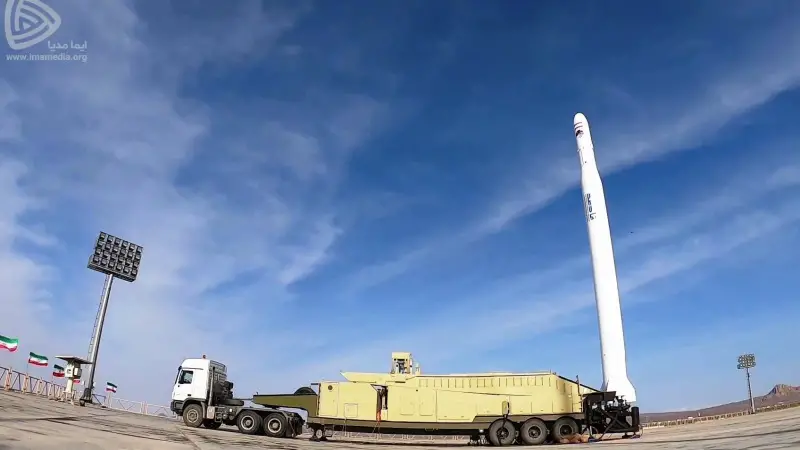The Aerospace wing of the Islamic Revolutionary Guard Corps (IRGC), using a Ghased launch vehicle (Qased) from the Shahroud Spaceport, placed the Noor 2 satellite in a 500-kilometre orbit.
The mission of this satellite is measurement and surveillance, and Noor 2 satellite. It was placed the orbit at a speed of 6.7 km / s and 480 seconds after launch.
Issa Zarehpour, the Minister of Communications and Information Technology, wrote on his social media that this is the first time Iran has placed a satellite 500 km in the LEO Orbit.
He also said that ground stations successfully received the first signals from Noor 2 satellite. The reconnaissance satellite will orbit the Earth every 90 minutes and fly over Iran 16 times a day and night, and its mission will last at least three years.
Sardar Ali Jafarabadi, Space Commander of the Air Force of the Islamic Revolutionary Guard Corps, said the information obtained from this satellite would be used in public and defense fields, and it is possible to identify and observe environmental phenomena and natural disasters from a height of 500 km with this satellite.
Noor 1 Satellite
On 22 April 2020, Iran launched the Noor 1 satellite (Nour). Despite forecasts of one year life, the Noor satellite is still functioning and active, transmitting information to Earth.
The “Noor 1” satellite has orbited 10,000 times so far
said Sardar Jafarabadi referring to the current situation of the Noor 1 satellite.
Noor-1 satellite is equipped with sensors that detect, receive and send signals, which tests several vital technologies and major subsystems, paving the way for the launch of subsequent satellites.
Noor 1 is currently at 347.9 km at elliptical orbit as per satellite tracking portals. At the altitude of 430 km circular orbit, the life of the satellites is about 2 to 3 years, and Noor 2 was intended to be placed in this orbit or above.
New series of Light satellites
Iran says its satellite roadmap has a larger scale, bigger satellites and higher orbits.
Referring to the IRGC’s future plans in the field of space research, Sardar Jafarabadi said: “We will launch a series of light satellites in the coming years, and the space program of the whole country, of which we are a part, is to stabilize in Leo orbit and put various scientific, research and defense satellites in this orbit and then be in the 36,000 km orbit of the Earth.”
Iranian Space Launch Vehicles
Iran’s first space launch vehicle Ghased-1 (Qased) uses Qadr ballistic missile propellants in its first phase and Salman solid propellent engine with moving the nozzle in the second phase. In the third stage, another liquid fuel propellant engine accelerates the satellite to the required speed and injects it into orbit.

As per Iranian media, Ghased-1 has a length of about 18.1 meters, mass is about 16 tons and can propel a 20 kg payload into space.
The first stage of Ghased-1 burns for about 118 seconds, after which it is is turned off and separated at an altitude of 80 km. The second stage separates at 290 seconds and a height of 415 km. Finally, the third stage engine injects the satellite into orbit at 480 km / h at 480 km / h at a speed of 7.65 km / h, equivalent to Mach 28.
Iran’s two stage Simorgh space launch vehicle, also called Safir-2, is the successor to Iran’s first space launcher, Safir. Simorgh failed to place three satellites into orbit in December 2021 after the rocket lost its speed after launch.
In February 2021, Iran announced its new 84 foot 3 stage Zuljanah launch vehicle (Zol-Jannah). It was reported that the rocket uses a solid-fuel engine in its first and second stages and a liquid-fuel engine in its third stage. According to the Ministry of Defense of the Islamic Republic, it is Iran’s most powerful launch vehicle to date. It can launch a satellite weighing 220 kilograms into low Earth orbit to 500 kilometres.
History of Iran’s Space Program
The Iranian authorities began developing space technologies back in the early 2000s when they considered creating a space launch vehicle based on Shahab-4 combat missiles. In 2009, Iran completed the construction of the domestic cosmodrome Semnan. Tehran successfully launched the Safir-2 launch vehicle into orbit for the first time from Semnan. Then, for several years, animals were launched into suborbital flight.
Since 2015, the space program was curtailed due to high costs. In 2019, Iran, continuing its development, launched the Simorgh rocket with the Payam satellite from the Semnan cosmodrome. It failed to reach its intended orbit, and the rocket crashed in the southern Indian Ocean. In the same year, the launch of the Safir rocket with the Dusti satellite failed. But in 2020, Iran launched its first military satellite Noor 1.
Sanctions
Maj. Gen. Hossein Salami, Commander-in-Chief of the Islamic Revolutionary Guard Corps, told local media that the Islamic Republic of Iran is the first Muslim country to launch a satellite into space. He said during the past years; they were able to take this step in this atmosphere of sanctions.
